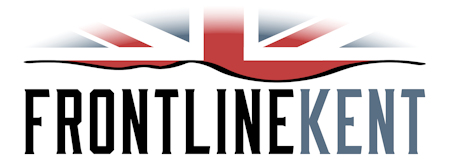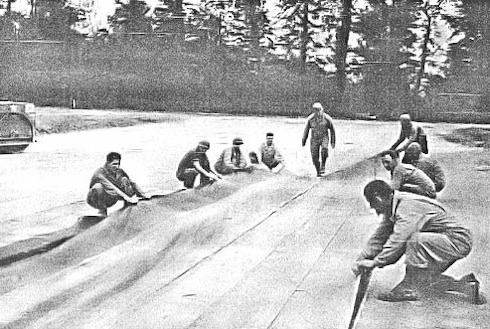Advanced Landing Grounds

designed for fighters such as Hurricanes and Spitfires or light bombers, such as the Mosquito, but were not large enough to support bombers such as the Lancaster or Stirling.
It was originally planned to build 72 ALG’S in Southern England but some remained on the planning board. In fact only 23 were eventually built. Their potential value in supporting the D-Day landings could not be disputed but some of them were planned to be built on prime agricultural land. This led to disputes between farmers and the government. In some cases, the government had to compulsory purchase land under the Defence of the Realm Act.
The construction of those ALG’s that were built took longer than planned, primarily as the land chosen was not always the best drained. The RAF Airfield Construction Groups and Airfield Construction Groups of the Royal Engineers built them. Kent had eleven ALG’s, with four on Romney Marsh. By any standards they were basic as it was only thought that they would be in use for a very short period of time – as proved to be the case. Other than the runway, the ALG’s had little else. Those who worked at these bases were expected to live in tents.
text courtesy of The History Learning Site
Locations of the four ALGs on Romney Marsh
Advanced Landing Grounds were built in Kent during 1943 and 1944 for several reasons. The first being a requirement by the allies to station short-range fighters close to the English Channel coast so missions could be undertaken to attack enemy coastal fortifications; road and rail networks and other military targets in Occupied France prior to the invasion of Normandy. Also construction of the ALGs provided necessary engineering and construction training as well as providing practical experience in the development of forward airfields which would be necessary on the Continent after the invasion. The ALG's laid down in Kent had two runways, while the ones laid down in France after the invasion generally had only one strip laid down east-west for speed of construction
Due to their temporary nature, the airfields were torn up and salvageable components were re-used on new ALGs in France after the assigned units were moved forward onto French ALGs after the invasion of Normandy

Laying an Advanced Landing Ground
Advanced Landing Grounds on Romney Marsh
The four airfield sites on Romney Marsh were all built on farmland, so many of the watercourses had to be piped and filled in, with some minor roads closed or diverted and properties demolished or requisitioned. The land chsosen was made level and then covered with a very heavy guage wire mesh, known as Somerfield track. The runways were 50ft wide but varied in lenght.
The ALGS were designed for fighters such as Hurricanes and Spitfires or light bombers, such as the Mosquito, but were not large enough to support bombers such as the Lancaster or Stirling. In 1942 four such airfields were built on Romney Marsh, as bases for the fighters required to tackle the German fighters and fighter-bombers and the battle against the Flying Bombs in 1944.

Squadron Leader J H Iremonger of No. 486 Squadron,
standing by a Hawker Tempest at Newchurch in 1944
The Marsh was ideal for such airfields, given its proximity to the continent and its flat open landscape. The four were laid on farmland at Brenzett, Midley, Newchurch and St Mary in the Marsh. The airfields could only operate in the summer months as the Marsh was too wet in the winter, as it was not as well drained as it is today. The most important role played by the Romney Marsh airfields was in the fight againts the flying bombs which began crossing the Marsh in large numbers from June 1944.
All four airfields have long since been returned to agricultural use and very few signs remain of their existence.
The site for the ALG at Brenzett was chosen for an advanced landing ground in July 1942 and construction work on the 300-acre (1.2 km2) site of flat marshland commenced in 1943, it was due to open on 1 March 1943 but was not ready for occupation until September and the airfield opened as RAF Brenzett as part of RAF Fighter Command on 14 September 1943 with two Sommerfeld Tracking runways. It's headquarters was Moat House at Brenzett.
The first unit to use the airfield was 122 Sqn with Supermarine Spitfires in August 1943 who used it relieve pressure on their home airfield of RAF Kingsnorth five miles (8 km) to the north. The airfield was not used to support the D-Day landings but in July 1944 a Mustang Wing (No 133 Polish Fighter Wing) with three squadrons was based there, mainly on anti-flying bomb patrols.
The Mustang wing left in October 1944 and the airfield was no longer needed, and closed on 13 December 1944, returning to agricultural use.
Location of the runways at Brenzett ALG
In 1972 the Brenzett Aeronautical Museum, a military and aviation museum, was opened near the site in buildings formerly occupied by the Women's Land Army.
![]() More about Brenzett Airfield
More about Brenzett Airfield
Midley ALG, also know as Lydd, was the first airfield to beome operational on the Marsh. Located west of Lydd at the site of an old airfield that was abandoned in 1919 and returned to agriculture.
The survey team looking for Advanced Landing Ground sites decided that the Walland Marsh to the west of Lydd was highly suitable and by the end of the year approval had been given for its development.
Midley opened on 25 June 1943, having been given the standard two Sommerfeld Track runways in a T'-shape with connecting perimeter-tracks. As usual, few buildings were provided and, as a base for mobile operations, tents were the order of the day.
The three Typhoon squadrons of No.121 Airfield arrived on 1 July and operations over France gave the squadrons and the airfield a thorough evaluation. The
Location of the runways at Midley ALG
The Typhoons moved out in early October and the airfield entered a second phase of construction, with repairs to the runway, provision of better dispersals and the erection of five Blister hangars.
It was decided, however, that Midley would be a reserve ALG and it did not receive an operational Wing during the D-Day period, although its near neighbours Brenzett and St Mary in the Marsh were both active.
The present Lydd airfield - or London Ashford Airport as it prefers to be
called - is situated to the east of Lydd and has no connection with the
wartime airfield.
![]() More about Midley Airfield
More about Midley Airfield

Nissen hut is the only visible remains of Midley ALG
Newchurch ALG was one of a number of Advanced Landing Grounds built in Kent during 1943. From July 1943 it became the base for three Spitfire and one Hurricane squadrons. In October 1943 the squadrons moved to RAF Detling while the airfield was improved.
In April 1944 it became the base of 150 Wing comprising three squadrons of Hawker Tempests. Commanded by Wing Commander Roland Beamont, the Newchurch Tempest Wing provided air cover for the Normandy landings and then tasked with defending against attacks by V-1 flying bombs.
The Wing destroyed 638 V-1s before leaving Newchurch to support the advance through Belgium and the Netherland.
No longer needed in December 1944 the airfield was restored to farmland.
There is a memorial dedicated to the airfield in its south-east corner.
Location of the runways at Newchurch ALG
The airfield was manned by No. 19 Squadron from 2 July to 18 August 1943, No.132 Squadron from 2 July to 12 October and No.602 Squadron from 13 August to 12 October 1943, all flying Spitfires.
No.184 Squadron flew Hurricanes from the airfield from 18 August to 12 October 1943, No.56 Squadron flew Spitfires and Tempests from 28 April to 23 September 1944 and No.3 Squadron flew Tempests from 28 April to 21 September 1944.
You can find out more about the Newchurch ALG on the Newchurch Village website.

Newchurch ALG, summer 1944 (Ack. 38)
[Click on map to view a larger version]
St Mary in the Marsh ALG, also know as New Romney, commenced operations on 2 July 1943 with its headquarters at Honeychild Manor about ¾ mile south east of St Mary in the Marsh village.
The airfield was manned by No.182 Squadron from 2 July to 10 October 1943, and Nos.181 and 247 Squadrons from 10 July to 9 October 1944. All three squadrons flew Typhoons.
You can find out more about all four of the Romney Marsh ALGs in Romney Marsh at War by Edward Carpenter.
Location of the runways at St Mary in the Marsh ALG


















